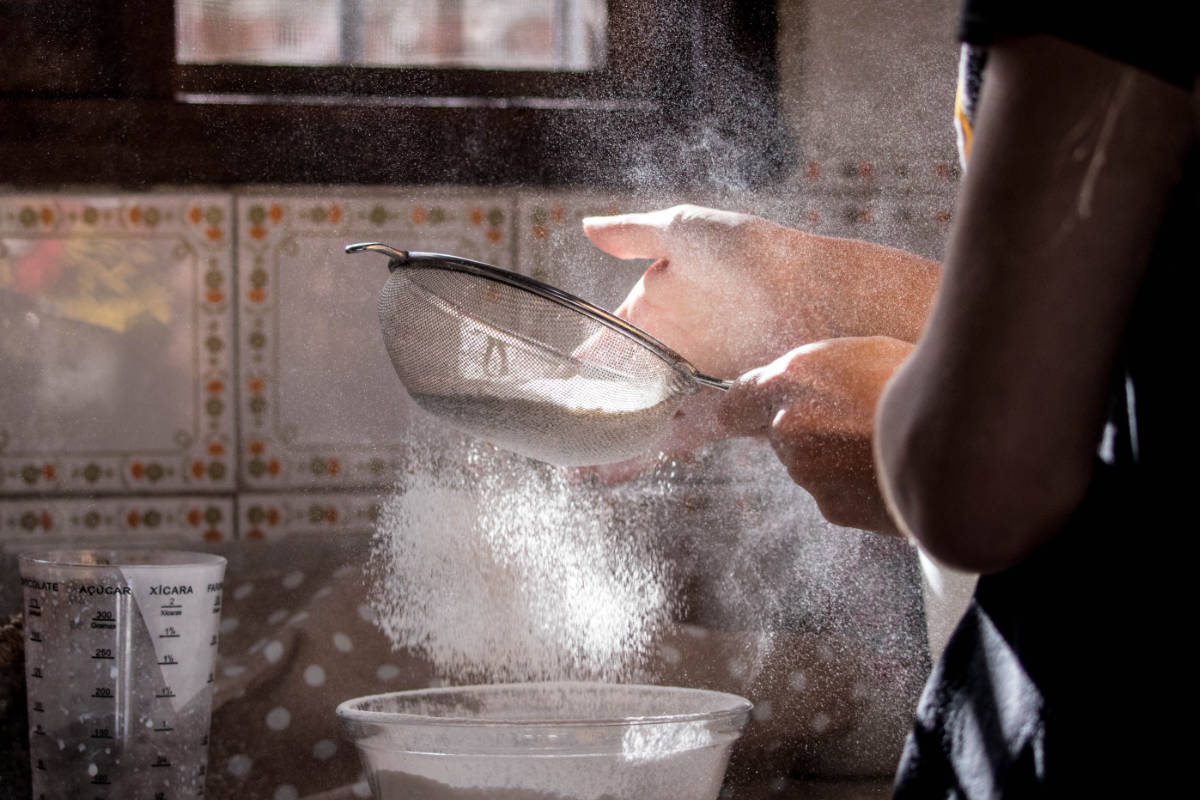When it comes to deciding the best flour for bread making, the answer falls into one of those “it really depends” kinds of situations. You should take into account everything from your skill level to your budget. Obviously, the taste preferences of the people who you are baking for matter as well. It’s still possible to answer this question, but that answer will most likely change from time to time as well.
Factors like protein content and what type of bread you’ll be making are very important when it comes to choosing the right flour. So, let’s take a look at the different factors that go into making that decision.
Protein content in flour
Some flours contain higher percentages of protein, which changes the way it reacts with liquids when you bake. This is generally due to what’s in the flour, like higher levels of bran and germ. It also contributes to some of the higher nutritional value of the bread you bake.
As you bake more and more, you’ll actually be able to “feel” the difference between these types of flour in your recipes. You’ll also notice that you’ll need more or less liquid depending on the protein level and how it reacts in your environment.
If you’re still interested, head over and read a bit more about protein content in flour.
Gluten content and why it matters
The gluten content of your bread is directly linked to the protein content of the flour that you use. The higher the protein content, the greater the amount of gluten in your final product. You can also affect the gluten in your dough by the way that you work it. More kneading and handling can help to produce more gluten structure, and less kneading can do the opposite.
That gluten in your dough is there to help produce a strong but fluffy structure in your bread. When you have the right amount of gluten in your dough, your end product will have the right texture and crumb. It will rise well and have a wonderful crust. It’s a balancing act, but the more you bake the more you’ll understand how gluten affects your bread and other baked goods.
The main flour types for bread making
There are far too many types of flour to go over in one article. I’m not an expert on all of them anyway. From einkorn flour to spelt, the flavors, textures, prices, and “cool factor” of some flours can be a lot to keep in your mind. But you don’t need to know it all. One of the great things about baking is that there’s always so much to learn.
However, we can talk about the main types of flours that you’re likely to encounter. Once you get familiar with these types of flours, you can make better choices when you’re at the grocery store. You can more easily alter recipes to suit your needs as well.
I’ll let you know some of my preferences, but this is more of an informational article. Besides, folks have their own very personal likes and dislikes…which is a great thing actually.
Whole wheat flour
Mmm, brown bread. This is the flour that went into the bread that I did not particularly love when I was a kid. Granted, I was brought up on Wonder Bread, which is not a horrible thing; however, it did leave me with a fairly one-dimensional palate for bread for most of my childhood.
Whole wheat flour is made from hard red spring wheat. The hull and other inedible bits are removed, and the bran, germ, and other good bits of the kernel are left to be milled. This gives the flour a darker color and a distinct, almost nutty flavor.
Whole wheat tends to have a higher protein content than all-purpose (AP) flour ranging somewhere between 11 and 16%, but it can be a bit tricky to use if you don’t have any experience baking with it. The fact that it includes the bran, which acts like tiny sharp shards in your dough slicing through the gluten strands that give your bread structure, means that it’s harder to get a nice, fluffy rise from whole wheat. It’s also one of the reasons that whole wheat bread tends to be more dense and heavy than bread made with “white” flour.
The shards obviously don’t hurt you, in fact, it’s quite the opposite. Those shards of bran contribute to the high levels of fiber in whole wheat bread. They just make developing a nice gluten strand in your dough a lot more difficult.
White whole wheat flour
Enter white whole wheat. Made from hard white spring wheat, this flour is an amazing middle ground between whole wheat and all-purpose flour. It brings along the nutritional value of whole wheat, as well as a similar protein content. It is still a bit more of a challenge to use than AP flour. However, it has a lighter color and a milder taste than regular whole wheat flour.
If you’re trying to make healthier bread for people who don’t love whole wheat, this might be your ticket. White whole wheat flour is still whole wheat. It’s just a different type of wheat with different qualities. Don’t think of it as whole wheat’s less nutritious cousin.
While it can be a little easier to work with than whole wheat, it does still require some finesse when baking loaves of bread. I recommend starting with 25% or so in your normal recipe. Then work your way up to 50% white whole wheat flour. After that, it’s all up to you. I will say though, this has become one of my favorite types of flour to work with. Try the King Arthur White Whole Wheat. It’s great stuff.
Bread flour
Bread flour features a higher protein content than AP flour, but it’s almost identical in every other way. It averages somewhere between 12 and 14% protein content and feels very similar to AP flour when used in a recipe.
It does take a bit more work to develop gluten using this flour, but the higher protein content means that you’ll get a better rise and a better structure than you might from just plain AP flour. You may also notice a difference in the crumb of your finished loaves. This type of flour can produce a tighter crumb, meaning that it has smaller, tighter holes in the texture of the loaf.
You can substitute bread flour in recipes that call for AP flour. Be mindful of the brand you substitute though. As King Arthur mentions on their site, the protein content varies quite a lot between brands. For instance, you might end up with a large swing if you substitute their bread flour in place of another brand’s AP flour that starts off with a much lower protein content to begin with.
All-purpose flour
I saved all-purpose (AP) flour for last. Mostly because it’s the type of flour that we all know and love. It’s also the type that we’re most comfortable with. AP flour is made with the same wheat as whole wheat flour, but it has the bran and germ removed as well as the hull. So, the texture of baked goods made with AP flour tends to be less dense and heavy than those made with whole wheat flour.
The protein content is generally somewhere between 8 and 11% with most AP flours, but as mentioned above this really does depend on the brand of flour you’re using. I’ve noticed that the protein content in AP flour contributes to the biggest difference in feel. A generic grocery store flour at 8 or 9% protein will feel much different than something like King Arthur AP flour at 11.7% when you’re baking bread.
As the name implies, this flour can be used for almost anything. You can make a wonderful loaf of sourdough bread, a babka, crumpets, and on and on. Just know that there’s a huge range of quality with AP flour. I go over a few of the brands I’ve tried below, but I recommend trying several different brands before you settle on one as your favorite.
When deciding between unbleached and bleached AP flour, you really want unbleached. Try to stay away from chemical processing as much as you can with your food. Unbleached AP flour can still produce very light and delicate baked goods, without the chemical bleaching process.
Other types of flour (specialty flours)
Like I mentioned earlier, there are lots of different types of flour that you can explore. If you don’t have access to a grocery store that stocks varieties other than the most popular, you can always check places online like Amazon’s bread section and other shops as well.
Here are a few that you might want to consider:
Rye – This one is pretty well known, and it’s delicious. If you like rye bread, you really should try baking with it. It can be more difficult to use than AP or bread flour, but you’ll notice a difference in taste and texture with as little as 10 or 20% rye in your flour mix.
When I make bread with rye flour, I still rarely go over 25 or 30% in my total mix. I usually buy the small 20oz bag of Bob’s Red Mill Dark Rye Flour and use that several times. It equals out to 567g of flour, and if I only use about 100 – 200g in my flour mix when I bake I can get three or four loaves of bread out of this little bag.
Einkorn – One of the oldest grains in the world, einkorn has some of the highest nutritional properties available but also some of the lowest gluten levels when it comes to bread flours. It has a mild flavor and is a great add-in flour for sourdough loaves. If you stick to about 20% or less, you should be fine using this unique flour.
Gluten-free – If you want to experiment with gluten-free flour, Bob’s Red Mill also sells a small bag of this variety. The bag lists garbanzo bean flour, potato starch, tapioca flour, whole grain sorghum flour, and fava bean flour as the ingredients. This can be one of the more difficult types of flour to get a good traditional bread result with. Often, you’ll need to use some amount of xanthan gum in addition to the gluten-free flour depending on what you’re making.
Popular brands of flour for bread making
While there are untold numbers when it comes to brands of flour, I only have significant enough experience with the following ones to write about them. Also, these are the brands that you will most likely find in your local store, online, and in recipes on baking blogs.
King Arthur Baking – King Arthur Unbleached All-Purpose flour is my favorite flour to make sourdough bread with…by far. The quality of the wheat, the high levels of protein, some kind of supernatural magic, not sure. But the feel of the dough when I’m working with it, doing stretch and folds, shaping, every step of the process feels better when I’m using this flour. Highly recommended.
Bob’s Red Mill – I used to live in Portland, OR. So, this flour was a sentimental favorite for a while. Their main facility is in Milwaukie, Oregon, which is just outside Portland. Their flour is high in quality and very good overall, in my opinion. If I need a specialty flour, like gluten-free, rye, or almond, I almost always go with Bob’s Red Mill.
Gold Medal – This one is easy to find, very affordable, and quite decent in quality. I used Gold Medal a bit during that odd time when we couldn’t get any flour during the Covid pandemic. In a pinch, I’d be pretty happy using this flour.
Simple Truth Organic – I actually think this flour is quite good for a store brand flour. It’s the organic generic brand from Kroger. If you have a Kroger owned store near you, grab a bag and see what you think. It’s not at the level of King Arthur, but it’ll do just fine.
Generic Grocery Store Brand – So, I thought I would mention this because I think people just aren’t sure how to feel about these. If you start to bake with one of the higher quality brands, you will absolutely notice the difference once you wind up with a bag of generic store flour; however, I also think some folks unnecessarily look down on these brands.
While you won’t get the same awesome results as you might from King Arthur or Bob’s Red Mill, you can still get some nice baked goods with generic flour. Also, at five bucks less per five-pound bag, you can almost think of it as “practice” flour. You’ll be a lot less afraid of making mistakes, and you’ll learn a lot more.
So, what’s the best flour for bread making?
Now that you’re armed with all of this knowledge, you can make the decision about what flour is the best for you and your situation. However, if you’re still unsure, I would recommend grabbing a bag of unbleached all-purpose flour and starting there. Try to get the best quality that you can, but don’t stress over it.
If you’re looking to jump into working with whole wheat flour but you’re a little intimidated, pick up a bag of white whole wheat flour. It’s a great stepping stone into working with whole wheat, and it’s healthy and delicious.
Once you’re past those points, grab something unusual or unfamiliar to you, and experiment. If you find something exciting, let us know in the comments. Have fun!





